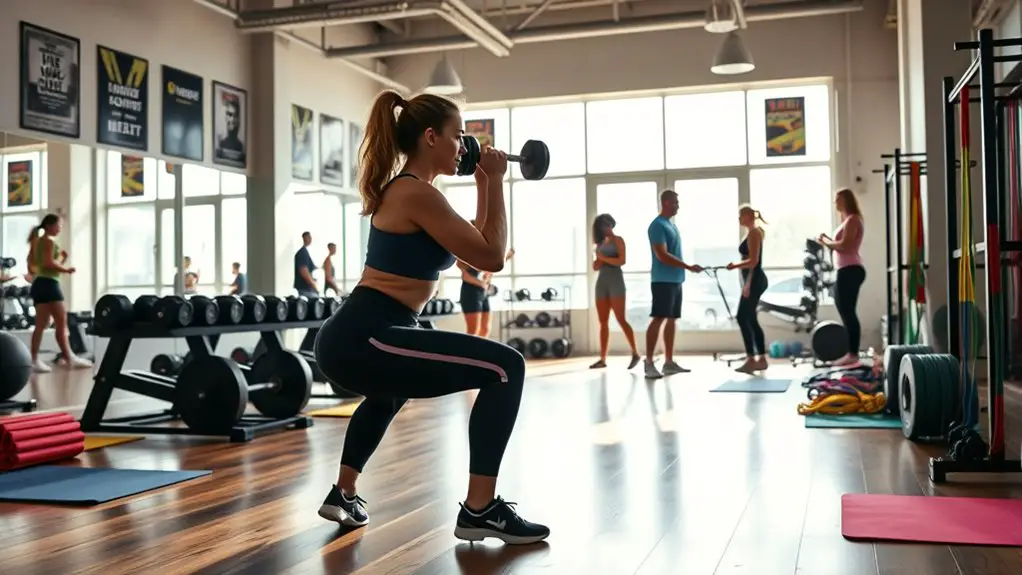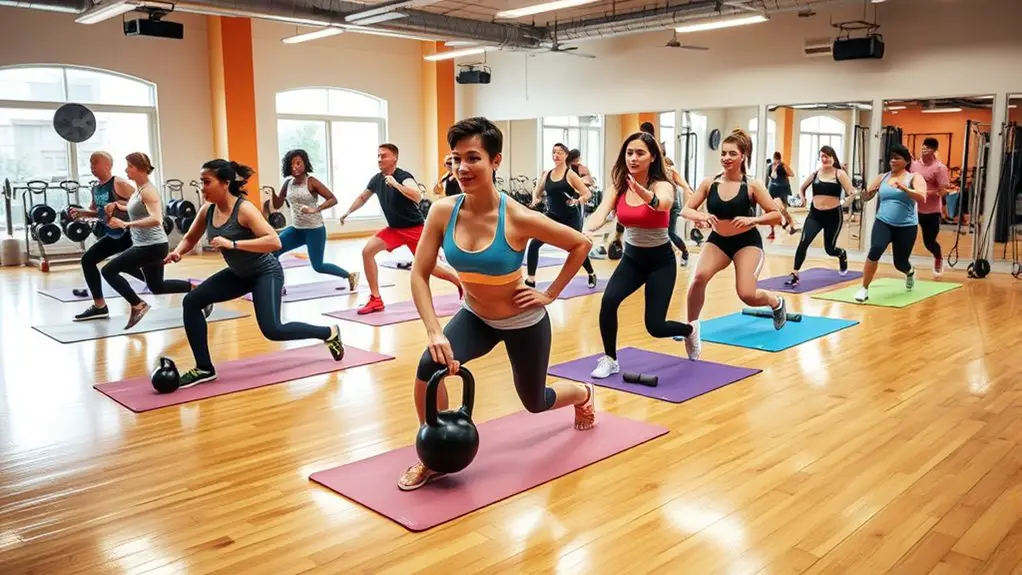The Ultimate 5-Day Gym Workout Plan

The Ultimate 5-Day Gym Workout Plan targets different muscle groups each day, ensuring balanced strength and fitness. You’ll kick things off with upper body strength training, then hit lower body muscles, followed by cardio and core conditioning. A full body circuit workout follows, wrapping up with flexibility and recovery. Don’t forget nutrition and hydration tips to optimize your performance. Keep going to discover how tracking your progress can keep you motivated each step of the way.
Overview of the 5-Day Workout Plan

When you commit to a 5-day gym workout plan, you’re setting yourself up for a balanced approach to fitness that targets different muscle groups while allowing adequate recovery time. Each day focuses on specific workout goals, ensuring that you’re not overworking any single area. This method not only enhances your strength but also minimizes the risk of injury.
You’ll use essential gym equipment like dumbbells, resistance bands, and machines tailored for each workout. It’s vital to follow proper form and listen to your body throughout the process. If you feel fatigued or experience discomfort, don’t hesitate to adjust your routine. Listening to your body is crucial for preventing injuries and ensuring effective workouts.
Planning your workouts in advance helps keep you motivated and accountable. As you progress through the week, you’ll notice improvements in your strength and endurance, paving the way for continued success in your fitness journey. Remember, safety always comes first!
Day 1: Upper Body Strength Training
On Day 1, you’ll focus on upper body strength training, targeting key muscle groups like your chest, back, shoulders, and arms. Begin with a warm-up to prepare your muscles and joints, ensuring safety during your workout. Use various equipment options, such as dumbbells, resistance bands, or machines, to enhance your strength techniques. Aim for a moderate workout intensity, adjusting weights according to your fitness level.
Incorporate compound exercises like bench presses and rows to work multiple muscle groups efficiently. Pay attention to form tips; maintaining proper posture and technique is essential to prevent injuries. Consider a training split that balances upper body and lower body workouts throughout the week for best recovery. After your session, implement recovery strategies like stretching and hydration to help your muscles heal and grow stronger. Remember, visible improvements in body composition will reflect your hard work and dedication. Enjoy the progress as you build your upper body strength!
Day 2: Lower Body Strength Training

As you plunge into Day 2, you’ll focus on lower body strength training, which is essential for building a strong foundation. Start with squat variations like bodyweight squats and goblet squats to engage your glutes and quads safely. Always verify your knees track over your toes and keep your back straight to prevent injury.
Next, incorporate deadlift techniques, such as the conventional and Romanian deadlifts. Begin with lighter weights to master your form, focusing on hinging at the hips and keeping your core tight. Remember to maintain a neutral spine throughout the movement.
Finish with accessory exercises like lunges and calf raises to round out your routine. Additionally, consider integrating the Half-Kneeling Cable Press for improved core engagement. As you progress, listen to your body and adjust weights as needed to stay safe. This balanced approach will help you build strength effectively while minimizing the risk of injury. Enjoy your workout!
Day 3: Cardio and Core Conditioning
Day 3 focuses on cardio and core conditioning, and it’s an integral part of any workout plan. Incorporating these elements not only boosts your endurance but also enhances your core stability, which is vital for overall strength. Here’s how to effectively structure your workout:
- Warm-up: Start with a 5-10 minute light jog or brisk walk to get your heart rate up and prepare your muscles.
- High Intensity Intervals: Engage in 20-30 minutes of high intensity intervals, alternating between short bursts of sprinting and recovery periods. This maximizes calorie burn and improves cardiovascular fitness.
- Core Exercises: Finish with core exercises like planks, Russian twists, and bicycle crunches to strengthen your midsection and support good posture. Incorporating jump rope into your routine can also enhance cardiovascular fitness and provide an excellent workout.
Remember to listen to your body and stay hydrated throughout your workout. Prioritize form over speed to guarantee safety and effectiveness.
Day 4: Full Body Circuit Workout

On Day 4, you’ll experience the benefits of a full body circuit workout, which can boost your strength and endurance. Don’t worry if you’re new to this; there are exercise modifications available to suit every fitness level. To enhance your workout, consider incorporating skipping rope as it serves as an excellent full-body workout that engages multiple muscle groups. Let’s explore how you can maximize your workout while keeping it accessible.
Circuit Workout Benefits
While you might think that strength training and cardio are separate workouts, circuit training seamlessly combines both for an efficient full-body workout. This method not only saves time but also maximizes your results. Here are three key benefits of circuit workouts:
- Improved Workout Efficiency: You’ll target multiple muscle groups in a shorter time frame, keeping your heart rate up and boosting calorie burn.
- Variety: Circuit training keeps things interesting, reducing the risk of boredom and plateaus.
- Flexibility: You can easily modify exercises to suit your fitness level, ensuring safety while challenging yourself.
Exercise Modifications for All
Circuit training offers a great way to engage in a full-body workout, but it’s important to remember that not every exercise suits everyone. To guarantee safety and injury prevention, consider these adaptive exercises that can modify intensity and impact.
| Exercise | Modification |
|---|---|
| Push-Ups | Knee Push-Ups |
| Jump Squats | Bodyweight Squats |
| Plank | Wall Plank |
| Burpees | Step-Back Burpees |
| Dumbbell Rows | Resistance Band Rows |
Day 5: Flexibility and Recovery
After pushing yourself through a week of workouts, Day 5 is all about flexibility and recovery. Stretching is essential for preventing injuries and improving your overall performance. Let’s explore some effective recovery techniques that’ll help you feel refreshed and ready for your next challenge. Incorporating light cardio exercises before stretching can significantly enhance your warm-up routine.
Importance of Stretching
Stretching is often overlooked, yet it’s an essential component of any workout routine, especially on Day 5, when the focus shifts to flexibility and recovery. Incorporating stretching into your regimen promotes dynamic flexibility and enhances overall performance. It’s vital for injury prevention, helping you stay safe as you push your limits. Here are three key benefits of stretching:
- Improves Range of Motion: Regular stretching increases your mobility, making movements more efficient.
- Reduces Muscle Tension: It helps relax tight muscles, promoting better recovery after intense workouts.
- Enhances Blood Flow: Stretching boosts circulation, delivering nutrients to your muscles and speeding up recovery.
Recovery Techniques Explained
Incorporating effective recovery techniques into your routine can considerably enhance your flexibility and overall performance on Day 5. Begin with foam rolling, which helps release muscle tightness and improve blood flow, making your workouts safer and more effective. Spend about 10-15 minutes rolling out major muscle groups, focusing on areas that feel particularly tight.
Next, engage in active recovery, such as light walking or gentle yoga. This keeps your body moving without overexerting yourself, promoting circulation and reducing soreness.
Lastly, don’t forget to hydrate and nourish your body with balanced meals, as this aids in recovery. By prioritizing these techniques, you’ll not only feel better but also boost your progress in the gym.
Nutrition Tips for Optimal Performance
To fuel your workouts effectively, it’s essential to focus on nutrition that enhances your performance. Implementing proper meal timing, hydration strategies, and nutrient timing can make a significant difference in your results. Here are three key tips to take into account:
- Meal Timing: Eat a balanced meal two to three hours before your workout. This helps guarantee you have the necessary energy without feeling sluggish.
- Hydration Strategies: Stay hydrated throughout the day, aiming for at least half your body weight in ounces of water. Proper hydration supports endurance and recovery.
- Protein Sources: Incorporate lean protein sources, like chicken, fish, or legumes, into your post-workout meals. Consuming protein within 30 minutes post-exercise aids in muscle recovery and growth. Additionally, understanding your daily protein needs can help in optimizing your intake for better performance.
Tracking Your Progress and Staying Motivated
While you might feel motivated at the start of your fitness journey, keeping that momentum going can be challenging. To maintain your drive, focus on goal setting by defining specific, achievable targets. Use motivation techniques like visual reminders, such as progress photos or inspirational quotes, to keep you inspired.
Progress tracking is essential; consider maintaining a workout journal to record your achievements and reflect on your growth. Sharing your journey with accountability partners can reinforce your commitment—having someone to encourage you makes a difference.
Incorporate positive reinforcement into your routine; celebrate small victories with a reward system that feels meaningful to you. Whether it’s treating yourself to new workout gear or a relaxing day off, these rewards can boost your motivation. By consistently tracking your progress and nurturing your motivation, you’ll create a sustainable path to success in your fitness journey. Additionally, monitoring your personal benchmarks over time can help assess your overall fitness journey.
Frequently Asked Questions
Can Beginners Follow This 5-Day Workout Plan?
They say, “Rome wasn’t built in a day,” and that’s true for your fitness journey too. Yes, beginners can follow this 5-day workout plan, but it’s essential to listen to your body. The beginner benefits include increased workout confidence and improved strength over time. Start slow, focus on form, and don’t hesitate to modify exercises to suit your level. Safety first; you’ll build a solid foundation for lasting results.
What Equipment Is Needed for These Workouts?
For these workouts, you’ll need a few key pieces of equipment to guarantee safety and effectiveness. First, having dumbbell variations is essential, as they offer versatility for strength training. You’ll also want resistance bands, which provide adjustable resistance and help prevent injury by promoting controlled movements. With these tools, you can safely progress through your workouts while building strength and stability, setting a solid foundation for your fitness journey.
How Long Should Each Workout Session Last?
When it comes to workout duration, you’ll want to strike a balance between intensity and safety. Aim for sessions lasting 45 to 60 minutes, ensuring you maintain proper form and avoid fatigue. Shorter, sharper workouts can be effective, but don’t underestimate the power of a well-paced session. Remember, it’s about quality over quantity—focus on intensity while keeping your body safe. Listen to your body, and adjust as needed for best results.
Is It Safe to Do This Plan Every Week?
It’s important to evaluate whether it’s safe to follow a workout plan every week. While consistency is key, you should be aware of overtraining risks. If you’re pushing your body without adequate rest, it can lead to fatigue and injury. Ideally, you’ll want to monitor your workout frequency and make sure you’re allowing enough recovery time. Listen to your body, and don’t hesitate to adjust your routine if you feel overly fatigued or sore.
Can I Modify Exercises for Injuries or Limitations?
Absolutely, you can modify exercises for injuries or limitations. In fact, studies show that 80% of people experience some form of injury during their fitness journey. Making exercise adaptations is essential for injury prevention and keeping you safe. If an exercise feels uncomfortable or painful, don’t hesitate to switch it up. Focus on movements that allow you to build strength and stay active without risking further injury. Your safety should always come first!





